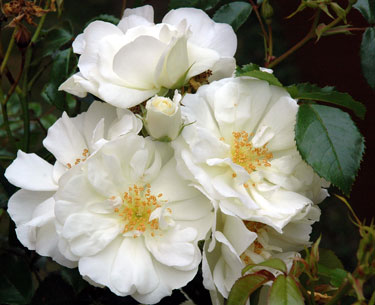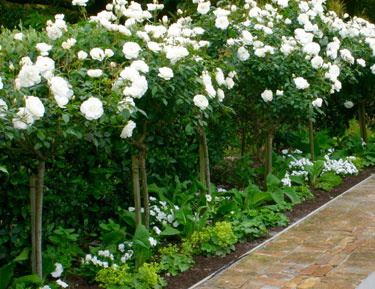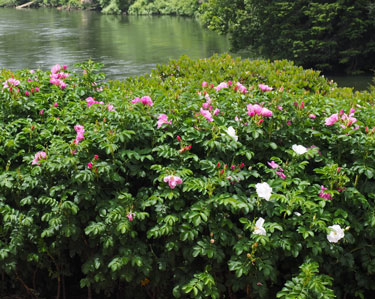No nonsense roses
When it comes to roses, the heart so easily rules the head. But we can all enjoy the world’s most romantic flower without pain or hard labour. Sue Linn takes a pragmatic look at roses.
Every winter as I pick the thorns from my fingers, I tell myself it’s time to rationalise my rose collection. Then spring comes around and I’m in love all over again, filling vases with colour and perfume and picking bunches for friends. Each spring another irresistible purchase or two finds its way home from the garden centre. All resolve goes out the window. A few months later, late summer pests and diseases escalate and I’m glad my roses are tucked around a corner away from the main garden view.
Every rose has its thorn as the saying goes, but some roses are infinitely easier to grow than others and truly give bang for their buck. The trick is to choose varieties that give a very long flowering season and flourish without asking for any fussy pruning or spraying.
Disease resistance is top priority. Many old fashioned and wild varieties of roses are very trouble free. The best of the old ramblers can go years without pruning. Any ancient variety that’s prevailed through the centuries and is still grown today has remained in favour for good reason. Many of them have great disease resistance.
In the age of smaller gardens, however, we want these attributes on smaller plants that flower for even longer. To meet that need, the best of those old rose genes have been bred into modern roses. The most famously disease resistant are the Flower Carpet roses, which can be grown without spraying and offer a wide choice of colours and growth habits. Their flowers evoke the romantic old style but there are a lot more of them over a much longer flowering season and they’ll slot easily into in any sized garden.
No nonsense pruning is the other thing that makes shrub and ground cover roses so easy. Using hedge shears they are simply and quickly cut back to a third their size in late winter or early spring to maintain their size and promote a fresh flush of rich shiny foliage and flowers.
Modern shrub and ground cover roses are so free flowering, easy and inexpensive to maintain that they have become among the most popular flowering plants for public gardens. But they’re just as perfect for home gardens, whether that is as a ground cover shrub, a mini weeping ‘tree’, a wall plant or fence embellishment, or as a colourful container plant.
Disease resistant roses
WHITE
Flower Carpet White (shrub)
Iceberg (floribunda)
Rugosa roses (old shrub roses)
Sparkler (shrub)
Anniversary (floribunda)
Racy Lady (hybrid tea)
PINK
Aotearoa (hybrid tea)
Flower Carpet Roses (shrubs and groundcovers)
Rugosa roses (old shrub roses)
Wise Woman (hybrid tea)
Aotearoa (hybrid tea)
Uetersen (climber)
RED
Flower Carpet Red (shrub)
Lasting Love (hybrid tea)
Trumpeter (floribunda)
Dublin Bay (climber)
Sweet Spot Calypso (shrub)
YELLOW/APRICOT
Easy Going (floribunda)
Kaiteri Gold (climber)
Serendipity (floribunda)
Flower Carpet Roses (shrubs)
Sweet Spot Yellow (shrub)
When choosing roses for easy care look for:
- Disease resistance
- Ease of pruning
- Compact growth (short internodes)
- Self-cleaning petal drop (no dead-heading required)
- Prolific flowering (more flowers and longer flowering periods)
Getting the best from your roses
- All roses reward us for feeding them with strong shiny disease resistant growth and more flowers.
- Feed them in spring and autumn and water them over summer.
- Deep infrequent watering is preferable to a daily sprinkle that only wets the surface.
- Roses grown in pots need extra watering and feeding with controlled release fertiliser.

1-Sep-2017

White Flower Carpet Rose

Standard Iceberg roses

Rugosa roses

Hybrid tea rose Paddy Stephens

